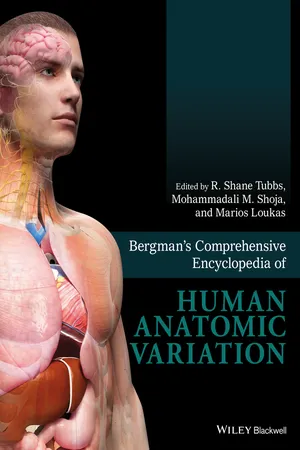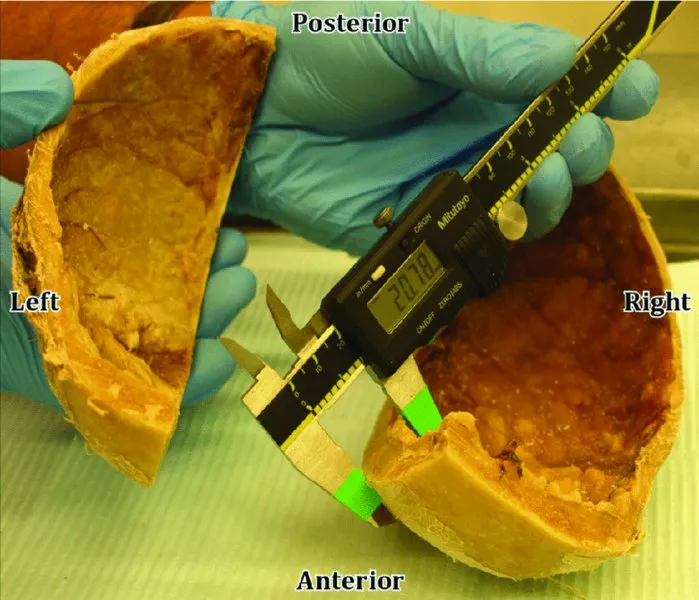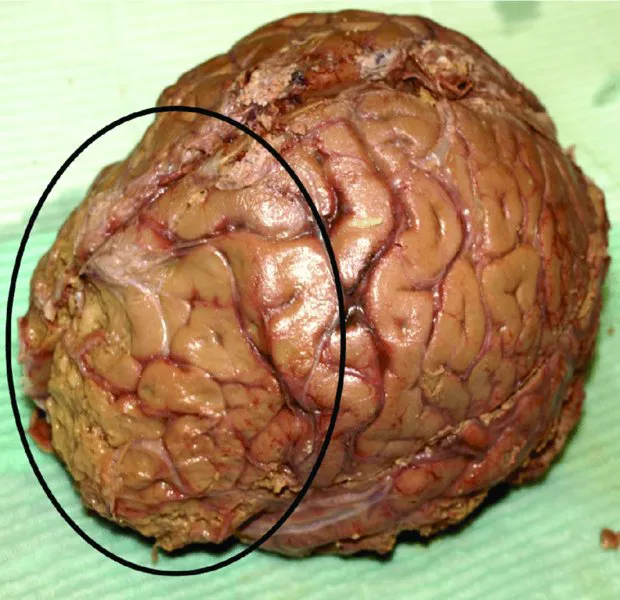
eBook - ePub
Bergman's Comprehensive Encyclopedia of Human Anatomic Variation
- English
- ePUB (mobile friendly)
- Available on iOS & Android
eBook - ePub
Bergman's Comprehensive Encyclopedia of Human Anatomic Variation
About this book
Building on the strength of the previous two editions, Bergman's Comprehensive Encyclopedia of Human Anatomic Variation is the third installment of the classic human anatomical reference launched by Dr. Ronald Bergman. With both new and updated entries, and now illustrated in full color, the encyclopedia provides an even more comprehensive reference on human variation for anatomists, anthropologists, physicians, surgeons, medical personnel, and all students of anatomy.
Developed by a team of editors with extensive records publishing on both human variation and normal human anatomy, Bergman's Comprehensive Encyclopedia of Human Anatomic Variation is the long awaited update to this classic reference.
Frequently asked questions
Yes, you can cancel anytime from the Subscription tab in your account settings on the Perlego website. Your subscription will stay active until the end of your current billing period. Learn how to cancel your subscription.
No, books cannot be downloaded as external files, such as PDFs, for use outside of Perlego. However, you can download books within the Perlego app for offline reading on mobile or tablet. Learn more here.
Perlego offers two plans: Essential and Complete
- Essential is ideal for learners and professionals who enjoy exploring a wide range of subjects. Access the Essential Library with 800,000+ trusted titles and best-sellers across business, personal growth, and the humanities. Includes unlimited reading time and Standard Read Aloud voice.
- Complete: Perfect for advanced learners and researchers needing full, unrestricted access. Unlock 1.4M+ books across hundreds of subjects, including academic and specialized titles. The Complete Plan also includes advanced features like Premium Read Aloud and Research Assistant.
We are an online textbook subscription service, where you can get access to an entire online library for less than the price of a single book per month. With over 1 million books across 1000+ topics, we’ve got you covered! Learn more here.
Look out for the read-aloud symbol on your next book to see if you can listen to it. The read-aloud tool reads text aloud for you, highlighting the text as it is being read. You can pause it, speed it up and slow it down. Learn more here.
Yes! You can use the Perlego app on both iOS or Android devices to read anytime, anywhere — even offline. Perfect for commutes or when you’re on the go.
Please note we cannot support devices running on iOS 13 and Android 7 or earlier. Learn more about using the app.
Please note we cannot support devices running on iOS 13 and Android 7 or earlier. Learn more about using the app.
Yes, you can access Bergman's Comprehensive Encyclopedia of Human Anatomic Variation by R. Shane Tubbs, Mohammadali M. Shoja, Marios Loukas, R. Shane Tubbs,Mohammadali M. Shoja,Marios Loukas in PDF and/or ePUB format, as well as other popular books in Biological Sciences & Human Anatomy & Physiology. We have over one million books available in our catalogue for you to explore.
Information
1
Skull
Selcuk Tunali
TOBB University of Economics and Technology, Ankara, Turkey
University of Hawaii, Honolulu, Hawaii, United States
University of Hawaii, Honolulu, Hawaii, United States
Frontal bone
The frontal sinus ostium is sometimes absent. In a cadaveric study, Ozgursoy et al. (2010) reported absence of right frontal sinus ostium in 3.6% of cases when there was a connection between the right and left frontal sinuses. They also noted that if one of the frontal sinus ostia cannot be found during sinus surgery, although this sinus and its recess can be seen on thick-sliced coronal computed tomographic scans, there could be an agenetic frontal sinus hidden by the extensive pneumatization of the contralateral sinus that crosses the midline (3.6%).
The frontal sinus itself can be absent. Computed tomographic scans in the axial and coronal planes of the frontal sinuses of 565 patients were examined. There was bilateral agenesis of the frontal sinus in 8.32% of these cases and unilateral absence of the frontal sinus in 5.66% (Danesh-Sani et al. 2011).
Another study investigated the prevalence of agenesis of the frontal sinuses using dental volumetric tomography (DVT) in Turkish individuals. The frontal sinuses of 410 patients were examined by DVT scans in the coronal plane. There was bilateral and unilateral absence of the frontal sinuses in 0.73% and 1.22% of cases, respectively (Çakur et al. 2011aa). Aydinlioğlu et al. (2003) studied computed tomography (CT) scans of the paranasal sinuses in the axial and coronal planes from a series of 1200 cases. Bilateral and unilateral absences of the frontal sinuses were noted in 3.8% and 4.8%, respectively.
In a study on the septation of the frontal sinuses, Comer et al. (2013) concluded that frontal sinus septations appear to be significantly associated with and predictive of the presence of supraorbital ethmoid cells. Identifying frontal sinus septations on sinus CT could therefore imply a more complex anatomy of the frontal recess.
In a study by Bajwa et al. (2013), all patients older than 15 months and 23 days had completely fused metopic sutures. The estimated median age for the start of the fusion process was 4.96 months (95% confidence interval, 3.54–6.76 months), and the estimated median age for completion of fusion was 8.24 months (95% confidence interval, 7.37–9.22 months). The fusion process was complete between 2.05 and 14.43 months of age in 95% of the normal population. There was no significant difference between sexes. This study demonstrated wide variation in the timing of normal fusion, which can complete as early as two months of age (Bajwa et al. 2013).
Persistent metopic sutures can be misdiagnosed as vertical traumatic skull fractures extending down the midline in head trauma patients. The surgeon should therefore be aware of this anatomical variant during primary and secondary surveillance of the traumatized patient and during surgical intervention, especially including frontal craniotomy. A reconstructed tomography scan demonstrating sutural closuring status could provide useful additional information in the diagnostic sequence, superior to a plain X-ray in the emergency setting (Bademci et al. 2007). Nakatani et al. (1998) encountered a complete ectometopic suture in a 91-year-old Japanese male cadaver during a gross anatomy course. It was observed in 1 of 26 skulls aged 62–92 years and was about 13 cm long from the bregma to the nasion. A metopic suture is rare in a person of advanced age, as in their case.
In another study, 1276 adult Indian skulls were examined for the incidence of metopic sutures. There was metopism in 2.66% of the skulls and metopic sutures were present in 38.17% (35.27% in the lower part of the frontal bone in various shapes); the incidences in the upper, upper middle and lower middle parts of the frontal bone were 0.8% in each location. As well as the abovementioned findings, a peculiar shape (inverted Y) was seen in 0.63% and a radiating type in 0.31% of the skulls (Agarwal et al. 1979).
Hyperostosis frontalis interna is a condition of bony overgrowth of the frontal region of the endocranial surface, appearing in the scientific literature as early as 1719. During routine dissection of a donor’s calvaria it was noted that she had significant bony overgrowth of the endocranium. Such overgrowth was diffuse throughout the frontal bone, extending slightly into the parietal region with midline sparing (Fig. 1.1). It ranged from 1.0 cm thickness in the temporal region to 1.3 cm adjacent to the midline in the frontal region. Large individual nodules were located along either side of the frontal crest at the intersection of the frontal and parietal bones. The largest nodules measured 2.08 cm in thickness on the right and 1.81 cm on the left (Fig. 1.2). As a result, the pathway of the middle meningeal artery was tortuous. In addition there was significant bilateral depression of the frontal lobes and surrounding neural tissues (Fig. 1.3) (Champion and Cope 2012).

Figure 1.1 Severe case of hyperostosis frontalis interna with typical midline sparing along the frontal crest. Notice the tortuous pathway of the middle meningeal artery. FC: frontal crest; GMMA: groove for middle meningeal artery.
Source: Champion and Cope (2012). Reproduced with permission from International Journal of Anatomical Variations.

Figure 1.2 Picture shows the measurement of a large nodule (2.08 cm) located adjacent to the frontal crest at the juncture of the frontal and parietal bones.
Source: Champion and Cope (2012). Reproduced with permission from International Journal of Anatomical Variations.

Figure 1.3 Notice the significant compression of the frontal lobes.
Source: Champion and Cope (2012). Reproduced with permission from International Journal of Anatomical Variations.
Nikolić et al. (2010) determined the rate of occurrence and appearance of hyperostosis frontalis interna (HFI) in females and correlated this phenomenon with aging. The sample included 248 deceased females, 45 with different types of HFI and 203 without HFI, average ages 68.3±15.4 (range 19–93) and 58.2±20.2 years (range 10–101), respectively. The rate of HFI was 18.14%. The older the woman, the higher the possibility of HFI (Pearson correlation 0.211, N=248, P=0.001), but the type of HFI did not correlate with age (Pearson correlation 0.229, N=45, P=0.131). The frontal and temporal bones were significantly thicker in women with HFI than in women without it (t=–10.490, DF=246, P=0.000, and t=–5.658, DF=246, P=0.000, respectively). These bones became thicker with aging (Pearson correlation 0.178, N=248, P=0.005 and 0.303, N=248, P=0.000, respectively). The best predictors of HFI were frontal bone thickness, temporal bone thickness, and age (respectively: Wald coefficient=35.487, P=0.000; Wald coefficient=3.288, P=0.070, and Wald coefficient=2.727, P=0.099). Diagnosis of HFI depends not only on frontal bone thickness but also on the waviness of the internal plate of the frontal bone and the involvement of the inner bone surface (Nikolić et al. 2010). May et al. (2011) studied two female populations separated by a period of 100 years: 992 historical and 568 present-day females. HFI was detected by direct observation or CT images. HFI was significantly more prevalent in the present-day than the historical females (P<0....
Table of contents
- Cover
- Title page
- Copyright
- Dedication
- List of contributors
- Preface
- Foreword
- Foreword
- 1 Skull
- 2 Hyoid bone
- 3 Cervical vertebrae
- 4 Thoracic vertebrae
- 5 Lumbar vertebrae
- 6 Sacrococcygeal vertebrae
- 7 Scapula
- 8 Clavicle
- 9 Humerus
- 10 Radius, ulna, carpals, metacarpals, and phalanges
- 11 Ribs and sternum
- 12 Pelvic bones
- 13 Bones of the lower limb
- 14 Temporomandibular joint
- 15 Shoulder joint
- 16 Elbow joint
- 17 Wrist and hand joints
- 18 Sacroiliac joints
- 19 Hip joint
- 20 Knee joint
- 21 Ankle and foot joints
- 22 Orbital muscles
- 23 Middle ear muscles
- 24 Facial muscles and muscles of mastication
- 25 Anterior neck muscles
- 26 Pharyngeal muscles
- 27 Soft palate and tongue muscles
- 28 Prevertebral and craniocervical junction muscles
- 29 Laryngeal muscles
- 30 Back muscles
- 31 Scapulohumeral muscles
- 32 Arm muscles
- 33 Forearm muscles
- 34 Hand intrinsic muscles
- 35 Thoracic wall muscles
- 36 Abdominal wall muscles
- 37 Pelvic diaphragm and external anal sphincter
- 38 Perineal muscles
- 39 Gluteal muscles and lateral rotators of the hip
- 40 Thigh muscles
- 41 Leg muscles
- 42 Intrinsic muscles of the foot
- 43 Internal carotid artery and the anterior cerebral circulation
- 44 Vertebrobasilar arteries
- 45 Persistent fetal intracranial arteries
- 46 Common carotid and cervical part of the internal carotid arteries
- 47 External carotid artery
- 48 Vertebral artery
- 49 Thoracic aorta
- 50 Coronary arteries
- 51 Pulmonary arteries
- 52 Subclavian artery
- 53 Upper limb arteries
- 54 Abdominal aorta
- 55 Renal arteries
- 56 Internal iliac arteries
- 57 Lower limb arteries
- 58 Arteries of the spinal cord
- 59 Diploic veins
- 60 Dural venous sinuses
- 61 Cerebral veins
- 62 Emissary veins
- 63 Veins of the neck
- 64 Veins of the upper limb
- 65 Intrathoracic veins
- 66 Cardiac veins
- 67 Pulmonary veins
- 68 Inferior vena cava, portal and hepatic venous systems
- 69 Adrenal, renal, gonadal, azygos, hemiazygos, lumbar, and ascending lumbar veins
- 70 Iliac veins
- 71 Veins of the lower limb
- 72 Venous drainage of the spinal cord
- 73 Thymus
- 74 Tonsils
- 75 Thoracic duct, cisterna chyli, and right lymphatic duct
- 76 Lymphatics of the lower limb
- 77 Forebrain
- 78 Cerebral ventricles
- 79 Pons, medulla oblongata and cerebellum
- 80 Subarachnoid space
- 81 Meninges
- 82 Spinal cord and associated structures
- 83 Cranial nerves N-VI
- 84 Facial nerve
- 85 Vestibulocochlear nerve
- 86 Glossopharyngeal nerve
- 87 Vagus, accessory, and hypoglossal nerves
- 88 Autonomic nervous system
- 89 Spinal nerves
- 90 Cervical plexus
- 91 Nerves of the upper extremity
- 92 Lumbosacral plexus
- 93 Facial asymmetry
- 94 Eyelids, eyelashes, and eyebrows
- 95 Eye and lacrimal apparatus
- 96 Lateral nasal wall and paranasal sinuses
- 97 Ear
- 98 Salivary glands and ducts
- 99 Thyroid gland
- 100 Parathyroid glands
- 101 Laryngeal cartilages
- 102 Trachea
- 103 Lungs
- 104 Heart
- 105 Esophagus
- 106 Stomach
- 107 Gallbladder and extrahepatic bile ducts
- 108 Liver
- 109 Pancreas
- 110 Spleen
- 111 Small intestines, appendix, and colon
- 112 Sigmoid colon, rectum, and anus
- 113 Kidney, urinary bladder, and ureter
- 114 Adrenal gland
- 115 Male genitourinary system
- 116 Female genital system
- 117 Placenta and umbilical cord
- 118 Breast
- Index
- EULA